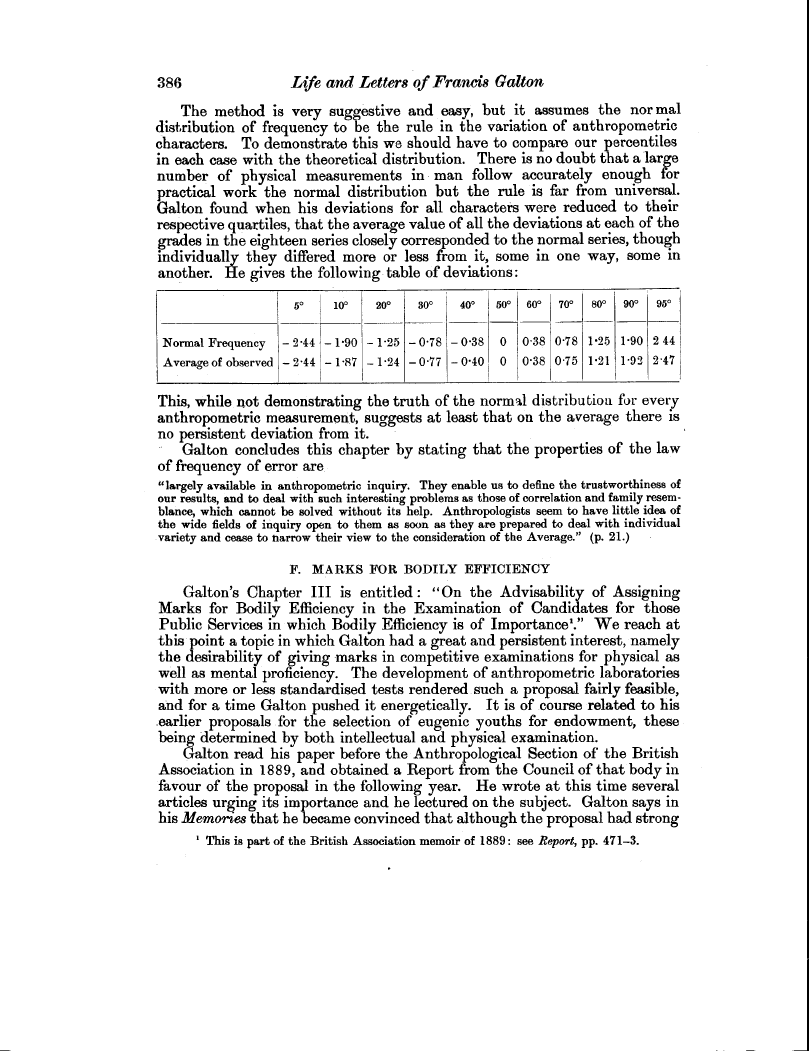386 Life and Letters of Francis Galton
The method is very suggestive and easy, but it assumes the nor mal distribution of frequency to be the rule in the variation of anthropometric characters. To demonstrate this we should have to compare our percentiles in each case with the theoretical distribution. There is no doubt that a large number of physical measurements in man follow accurately enough for practical work the normal distribution but the rule is far from universal. Galton found when his deviations for all characters were reduced to their respective quartiles, that the average value of all the deviations at each of the
es in the eighteen series closely corresponded to the normal series, though individually they differed more or less from it, some in one way, some in another. He gives the following table of deviations
| |
5° |
10° |
20° |
30° |
40° |
50° |
60° |
70° |
80° |
90° |
95° |
|
Normal Frequency |
-2-44 |
-1.90 |
-1-25 |
-0-78 |
-0-38 |
0 |
0.38 |
0.78 |
1.25 |
1.90 |
2 44 |
|
Average of observed |
-2-44 |
-1.87 |
-1-24 |
-0-77 |
-0-40 |
0 |
0.38 |
0.75 |
1.21 |
1.92 |
2.47 |
This, while not demonstrating the truth of the normal distribution for every anthropometric measurement, suggests at least that on the average there is no persistent deviation from it.
Galton concludes this chapter by stating that the properties of the law of frequency of error are
"largely available in anthropometric inquiry. They enable us to define the trustworthiness of our results, and to deal with such interesting problems as those of correlation and family resemblance, which cannot be solved without its help. Anthropologists seem to have little idea of the wide fields of inquiry open to them as soon as they are prepared to deal with individual variety and cease to narrow their view to the consideration of the Average." (p. 21.)
F. MARKS FOR BODILY EFFICIENCY
Galton's Chapter III is entitled : "On the Advisability of Assigning Marks for Bodily Efficiency in the Examination of Candidates for those Public Services in which Bodily Efficiency is of Importance'." We reach at this point a topic in which Galton had a great and persistent interest, namely the desirability of giving marks in competitive examinations for physical as well as mental proficiency. The development of anthropometric laboratories with more or less standardised tests rendered. such a proposal fairly feasible, and for a time Galton pushed it energetically. It is of course related to his .earlier proposals for the selection of eugenic youths for endowment, these being determined by both intellectual and physical examination.
Galton read his paper before the Anthropological Section of the British Association in 1889, and obtained a Report from the Council of that body in favour of the proposal in the following year. He wrote at this time several articles urging its importance and he lectured on the subject. Galton says in his Memories that he became convinced that although the proposal had strong
' This is part of the British Association memoir of 1889: see Report, pp. 471-3.

